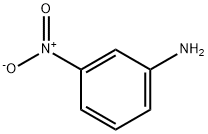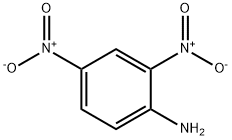A6154412
3-Nitroaniline , 98% , 99-09-2
Synonym(s):
3-Aminonitrobenzene
CAS NO.:99-09-2
Empirical Formula: C6H6N2O2
Molecular Weight: 138.12
MDL number: MFCD00007782
EINECS: 202-729-1
Update time: 2022-07-08
PRODUCT Properties
| Melting point: | 111-114 °C (lit.) |
| Boiling point: | 306 °C |
| Density | 0,901 g/cm3 |
| vapor pressure | 1 mm Hg ( 119 °C) |
| refractive index | 1.6396 (estimate) |
| Flash point: | 196 °C |
| storage temp. | Store below +30°C. |
| solubility | 1.25g/l |
| form | Crystals, Crystalline Powder and/or Chunks |
| Colour Index | 37030 |
| pka | 2.466(at 25℃) |
| Specific Gravity | 0.901 |
| color | Yellow to ochre-yellow to orange |
| Water Solubility | 1.25 g/L |
| Merck | 14,6581 |
| BRN | 636962 |
| Henry's Law Constant | 1.93 x 10-5 atm?m3/mol at 25 °C (approximate - calculated from water solubility and vapor pressure) |
| CAS DataBase Reference | 99-09-2(CAS DataBase Reference) |
| NIST Chemistry Reference | m-Nitroaniline(99-09-2) |
| EPA Substance Registry System | m-Nitroaniline (99-09-2) |
Description and Uses
Dyestuff intermediate. Acetylation of 3-nitroaniline followed by reduction gives 3-aminoacetanilide. Diazotization, followed by reduction of the diazosulfonate with ammonium bisulfite and subsequent hydrolysis, gives (3-nitrophenyl) hydrazine; an intermediate in the production of pyrazolone azo coupling components. 3-Nitroaniline is used as a diazo component (Fast Orange R Base) in azo dyes (e.g., C.I. Disperse Yellow 5 and C.I. Acid Orange 18).
Safety
| Symbol(GHS) |   GHS06,GHS08 |
| Signal word | Danger |
| Hazard statements | H301+H311+H331-H373-H412 |
| Precautionary statements | P273-P280-P301+P310+P330-P302+P352+P312-P304+P340+P311-P314 |
| Hazard Codes | T |
| Risk Statements | 23/24/25-33-52/53 |
| Safety Statements | 28-36/37-45-61-28A |
| RIDADR | UN 1661 6.1/PG 2 |
| WGK Germany | 2 |
| RTECS | BY6825000 |
| F | 8 |
| Autoignition Temperature | 521℃ |
| TSCA | Yes |
| HazardClass | 6.1 |
| PackingGroup | II |
| HS Code | 29214210 |
| Hazardous Substances Data | 99-09-2(Hazardous Substances Data) |
| Toxicity | Acute LD50 for guinea pigs 450 mg/kg, mice 308 mg/kg, quail 562 mg/kg, rats 535 mg/kg (quoted, RTECS, 1985). |



